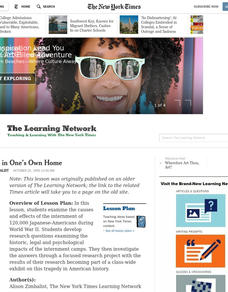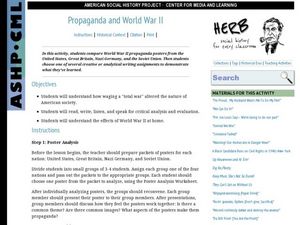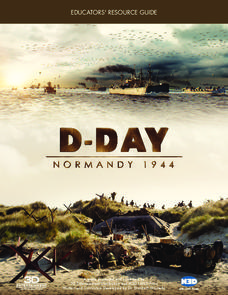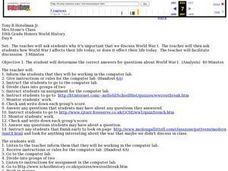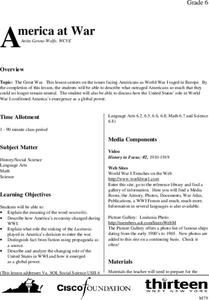Curated OER
To the North: A Black Family Leaves Arkansas to Find Work in Michigan
Upper elementary and middle school scholars study the economic factors that caused so many Arkansans to migrate to different parts of the country looking for work. Use this history lesson plan to help your charges gain a better...
Curated OER
Coming of Age During Japanese Occupation: Richard E. Kim's Lost Names: Scenes from a Korean Boyhood
Explore the implications of the Japanese occupation of Korea during World War II. Learners read Lost Names: Scenes from a Korean Boyhood, participate in classroom discussions about the novel and keep journals in which they respond to...
Curated OER
Prisoner in One's Own Home
Examine the internment of Japanese-Americans during World War II. After reading an article from the New York Times and exploring the author's word choice, young readers find the central idea in the text and work on researching additional...
Curated OER
Propaganda and World War II
What was the true meaning behind WWII propaganda posters? Historians analyze images from the U.S., Great Britain, Nazi Germany, and the Soviet Union, sharing findings in small groups. A poster analysis worksheet and all posters are...
D-Day Normandy 1944
D-Day Normandy 1944
No study of World War II would be complete without an in-depth examination of the events of June 6, 1944. Pascal Vuong's D-Day Normandy:1944, is the perfect vehicle to convey the sheer magnitude of the events that have been called the...
Curated OER
Fifth Grade Social Studies
For this social studies worksheet, 5th graders answer multiple choice questions about World War II, the transcontinental railroad, slavery, and more. Students complete 25 questions.
Curated OER
Prepping for a World War I Test
Review your WWI unit with this helpful resource. Young historians group up, complete a series of web-based activities, take a pop quiz, and examine the contents of a trunk considering items that would be most important during WWI. The...
Curated OER
Weapons of World War I Worksheet
In this World War I worksheet, students examine a weapons timeline and respond to 5 short answer questions. Students then read 2 articles about airplane dogfights in war and respond to 3 short answer questions.
Curated OER
Compare and Contrast Night to Life is Beautiful
After reading Elie Wiesel's Night, watching the movie Life is Beautiful, and researching World War II, class members write a comparison essay on the book and film. This includes a prior knowledge activity, discussion in whole and small...
Teach With Movies
Learning Guide to: Schindler's List
Take your history class through Schindler's List with a learning guide, which offers an introduction to the film and a variety of discussion questions and related assignments. There are several useful resources in the sidebar, such as a...
Student Handouts
The Cold War: The Truman Doctrine of 1947
What was the Truman administration's position on foreign policy during the Cold War? Class members respond to an excerpt from President Harry S. Truman's "Truman Doctrine" with three questions in the space provided.
American Battle Monuments Commission
The Meuse-Argonne Offensive
America's entrance into World War I drastically changed the scope of the conflict. An interactive map and timeline takes learners through the Meuse-Argonne Campaign, which lasted from September 26, 1918, to the eventual German armistice...
Curated OER
World War II and Propaganda Efforts
Learners define propaganda and list the various propaganda techniques used to influence people. They identify propaganda methods used by the American Government to encourage Americans to support the war effort
US National Archives
WWII: Asia 1939-45 – Burma
Because World War II encompassed most of the globe in one way or another, many pivotal battles and events are not as visible in the history books, leaving veterans of these conflicts feeling overlooked by more famous skirmishes. High...
American Battle Monuments Commission
The Strategic Bombing Campaign
An extensive look at World War II details the strategic bombing campaign of the Allied forces. Beginning in September 1939 and ending in May 1945, the interactive map follows British and American forces throughout the bombing campaigns...
Curated OER
Lesson 3: U.S. Neutrality and the War in Europe, 1939-1940
Students examine the U.S. neutrality policies that preceded American involvement in World War II. In this World War II instructional activity, students explore the events in Europe from 1939 to 1940 and Roosevelt's decision to give...
Curated OER
United States Entry into World War I: Some Hypotheses About U.S. Entry
Students take a stand on a hypothesis for U.S. entry into World War I, supported by specific evidence.
Curated OER
Women and World War II
Learners determine the influence of World War II on women's roles in society. Students research the answers to questions about how women were able to enter jobs that had not been open to them before the war and how this affected society....
Curated OER
Women's Roles in World War Two
Students explore the various roles of women in the armed forces and their experiences at work. They discuss stereotypes of men and women during World War Two. They read extracts of stories from World War Two in small groups and report...
Curated OER
World War II: Concentration Camps and Refugees
Students explore the experiences of the people in the concentration camps at liberation during World War II. Students read an article on the Liberation of Belsen Concentration Camp and D-Day and report to the class.
Curated OER
America at War
Sixth graders examine issues that faced Americans during World War I, discuss role that sinking of the Lusitania had in America's decision to enter the war, and analyze changing role of U.S. during the war and how it emerged as a world...
Curated OER
The Unseen Army: Conscientious Objectors During World War II
Learners study World War II and why it was called "the Good War". In this World War II activity learners identify the different kinds of conscientious objectors.
Curated OER
The Road to World War II
Middle schoolers research the orgins and early events of World War II using online and off line resources. They conduct an interview with a local World War II veteral and present their findings to the class.
Curated OER
World War II in the Pacific and the End of the War
Students study the World War in the Pacific. In this Geography lesson, students develop an awareness of key issues and events from the conflict. Students write a well-organized essay describing this event.




